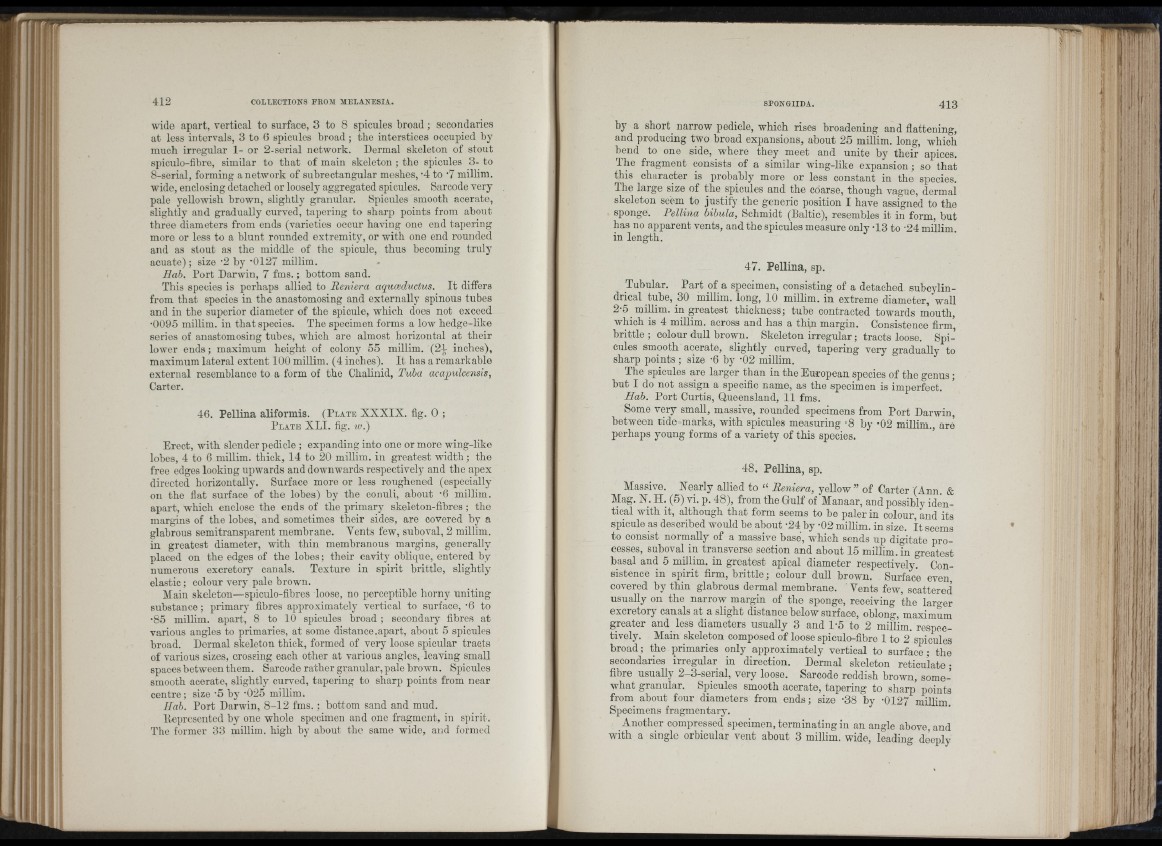
?
. ■ !
i : ■ V
i
: '
wide apart, vertical to surface, 3 to 8 spicules broad ; secondaries
at less intervals, 3 to 6 spicules broad ; the interstices occupied by
much irregular 1- or 2-serial network. Dermal skeleton of stout
spiculo-fibre, similar to th at of main skeleton ; the spicules 3- to
8-serial, forming a network of suhrectangular meshes, -4 to -7 millim.
wide, enclosing detached or loosely aggregated spicules. Sarcode very
pale yellowish brown, slightly granular. Spicules smooth acerate,
slightly and gradually curved, tapering to sharp points from about
three diameters from ends (varieties occur having one end tapering
more or less to a blunt rounded extremity, or with one end rounded
and as stout as the middle of the spicule, thus becoming truly
acuate) ; size -2 by -0127 millim.
Hab. Port Darwin, 7 fms. ; bottom sand.
This species is perhaps allied to Reniera aquoeductus. I t differs
from that species in the anastomosing and externally spinous tubes
and in the superior diameter of the spicule, whieh docs not exceed
•0095 millim. in th a t species. The specimen forms a low hedge-like
series of anastomosing tubes, which are almost horizontal at their
lower ends; maximum height of colony 55 millim. (24 inches),
maximum lateral extent 100 millim. (4 inches). I t has a remarkable
external resemblance to a form of the Chalinid, Tuba acapulcensts,
Carter.
46. Pellina aliformis. (P la te XXXIX. fig. 0 ;
P l a t e XLI. fig. tv.)
Erect, with slender pedicle ; expanding into one or more wing-like
lobes, 4 to 6 millim. thick, 14 to 20 millim. in greatest width ; the
free edges looking upwards and downwards respectively and the apex
directed horizontally. Surface more or less roughened (especially
on the flat surface of the lobes) by the conuli, about -6 millim.
apart, which enclose the ends of the primary skeleton-fibres ; the
margins of the lobes, and sometimes their sides, are covered by a
glabrous semitransparent membrane. Vents few, suhoval, 2 millim.
in greatest diameter, with thin membranous margins, generally
placed on the edges of the lobes ; their cavity oblique, entered by
numerous excretory canals. Texture in spirit brittle, slightly
elastic ; colour very pale brown.
Main skeletou—spiculo-fibres loose, no perceptible horny uniting
substance ; primary fibres approximately vertical to surface, -6 to
•85 millim. apart, 8 to 10 spicules broad ; secondary fibres at
various angles to primaries, at some distance .apart, about 5 spicules
broad. Dermal skeleton thick, formed of very loose spicular tracts
of various sizes, crossing each other at various angles, leaving small
spaces between them. Sarcode rather gi-anular, pale brown. Spicules
smooth acerate, slightly curved, tapering to sharp points from near
centre ; size -5 by -025 millim.
Hab. Port Darwin, 8-12 fms. ; bottom sand and mud.
Pepresented by one whole specimen and one fragment, in spirit.
The former 33 millim. high by about the same wide, and formed
by a short narrow pedicle, which rises broadening and flattening,
and producing two broad expansions, about 25 millim. long, which
bend to one side, where they meet and unite by their apices.
Ih e fragment consists of a similar wing-like expansion; so that
this character is probably more or less constant in the species.
The large size of the spicules and the coarse, though vague, dermal
skeleton seem to justify the generic position I have assigned to the
sponge. Pellina bibula, Schmidt (Baltic), resembles it in form, hut
has no apparent vents, and the spicules measure only -13 to -24 millim.
in length.
47. Pellina, sp.
Tubular. P a rt of a specimen, consisting of a detached subcylindrical
tube, 30 millim. long, 10 miUim. in extreme diameter, wall
2-5 millim. in greatest thickness; tube contracted towards mouth,
which is 4 millim. across and has a thin margin. Consistence firm]
brittle ; colour duU brown. Skeleton irreg u lar; tracts loose. Spicules
smooth acerate, slightly curved, tapering very gradually to
sharp p o in ts ; size -6 by -02 millim.
The spicules are larger than in the European species of the genus ;
but I do not assign a specific name, as the specimen is imperfect.
Hab. Port Curtis, Queensland, 11 fms.
Some very small, massive, rounded specimens from Port Darwin
between tide-marks, with spicules measuring -8 by -02 millim., are
perhaps young forms of a variety of this species.
48. Pellina, sp.
Massive. Nearly allied to “ Reniera, yellow ” of Carter (Ann &
Mag. N. H. (5) vi. p. 48), from the Gulf of Manaar, and possibly identical
with it, although th at form seems to be paler in colour, and its
spicule as described would he about -24 by -02 miUim. in size. I t seems
to consist normally of a massive base, which sends up digitate processes,
suboval in transverse section and about 15 millim. in greatest
basal and 5 millim. in greatest apical diameter respectively. Consistence
in spirit firm, b r ittle ; colour dull brown. Surface even
covered by thin glabrous dermal membrane. ’ Vents few, scattered
usually on the narrow margin of the sponge, receiving the larger
excretory canals at a slight distance below surface, oblong, maximum
greater and less diameters usually 3 and 1-5 to 2 millim. respectively.
Main skeleton composed of loose spiculo-fibre 1 to 2 spicules
broad; the primaries only approximately vertical to surface; the
secondaries irregular in direction. Dermal skeleton reticulate-
fibre usually 2-3-serial, very loose. Sarcode reddish brown, some-’
what granular. Spicules smooth acerate, tapering to sharp’ points
from about four diameters from ends; size -38 by •0127 millim.
Specimens fragmentary.
Another compressed specimen, terminating iu an angle above, and
with a single orbicular vent about 3 millim. wide, leading deeply
r
I
J
Uii
4 ii:
I : d
' J t '
, Î ■
' 1 ‘
,
i! '
I'i
: (
'Ui,
I': I
:!i'
I